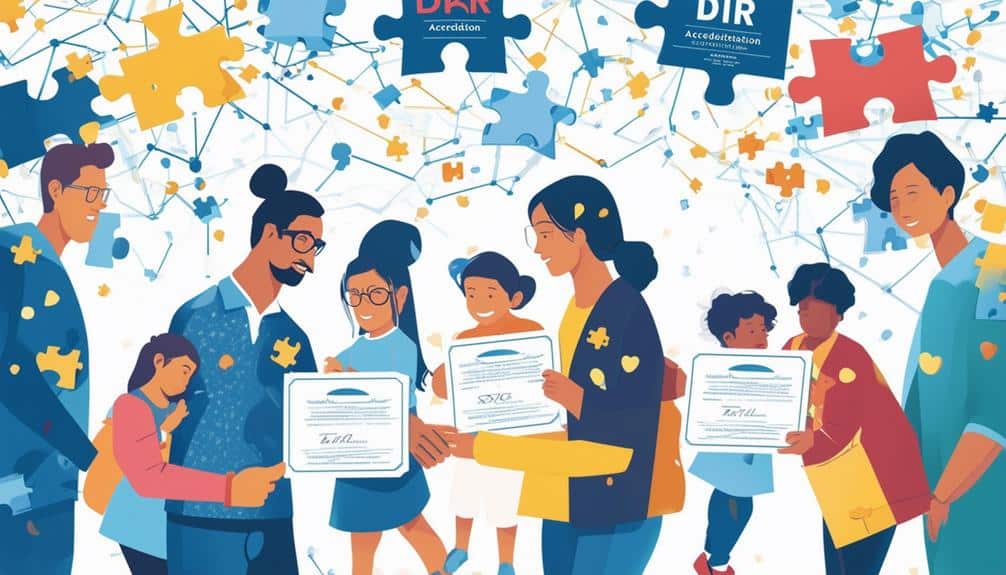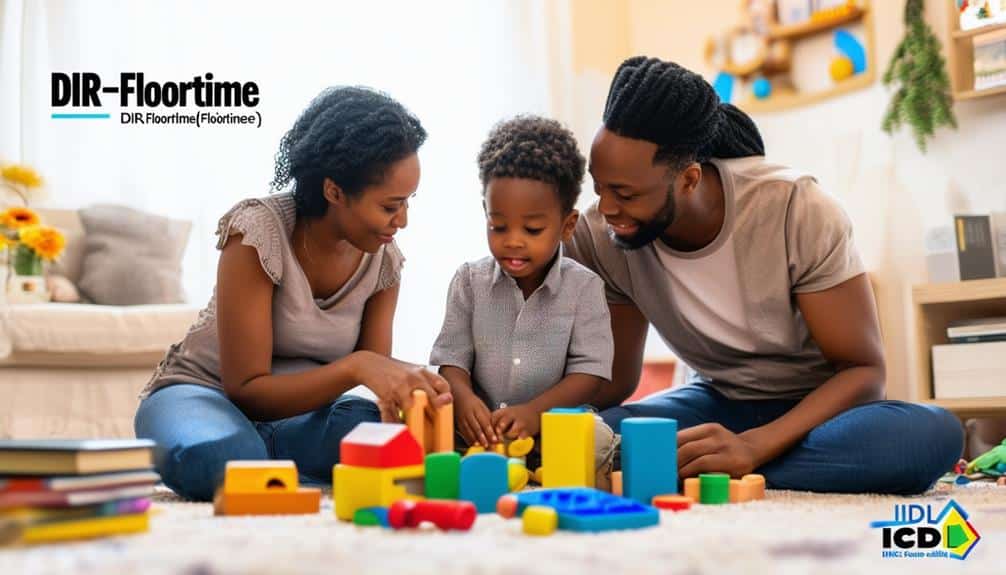DIR/Floortime is a trusted and effective autism therapy method that enhances family bonds and nurtures social communication skills. This approach, known for its deep empathic tone, revolves around your child’s interests, emotions, and developmental pace.
Actively participating in your child’s activities can boost family bonds and promote communication and emotional growth. This therapy accelerates progress in self-regulation, mutual interaction, and complex communication, giving your family a significant advantage. Explore this method further to see how it can be customized to your child’s unique needs and boost family bonds even more.
Key Takeaways
- DIR/Floortime focuses on parent-child interactions and strengthening family bonds by promoting shared experiences and understanding.
- The therapy encourages parents to engage in their child’s interests, augmenting communication and emotional growth.
- The DIR model emphasizes the importance of relationships, fostering intimacy, trust, and security within the family.
- Floortime therapy sessions are designed to fit seamlessly into daily routines, further integrating parents into their child’s developmental journey.
- The International DIR Institute offers programs and services to empower parents and reinforce their crucial role in their children’s progress and therapy.
Understanding DIR/Floortime
Delving into the heart of DIR/Floortime, this relationship-based therapy, established by Stanley Greenspan, M.D. and Serena Wieder, PhD in the 1980s, focuses on fostering robust relational connections and expanding communication circles between children with autism and their caregivers. The therapy’s central premise is that parent-child interaction, tailored to the child’s developmental level, can catalyze significant strides in interpersonal connections and communication.
DIR/Floortime operates on the principle of ‘meeting the child where they are.’ It encourages caregivers to engage in the child’s activities, supporting their interests and feelings, which enhances their self-regulation skills. By creating a calm, nurturing environment, Floortime sessions allow parents to follow their child’s lead, promoting a mutual exchange of gestures, expressions, and ideas.
The therapy’s collaborative design cultivates two-way, complex communication and the ability to express sentimental ideas and thinking. Furthermore, it fosters inclusion with peers, generating opportunities for children to develop abstract, logical thinking and enhance social-interpersonal skills. The ultimate goal is to broaden the child’s communication circles, provide the necessary tools to navigate their social world and enrich their overall quality of life.
Key Milestones in Floortime
In the journey of Floortime therapy, six key milestones serve as essential stepping stones towards fostering deeper connections between children with autism and their caregivers. These milestones promote growth and development, creating a path toward improved social, feeling, and intellectual capacities.
First and foremost, self-regulation is targeted to help the child understand and manage their sensory experiences and feelings. This stage sets the foundation for all future interactions, allowing the child to feel safe and ready to engage with others.
The second milestone focuses on intimacy in relationships. Through Floortime, caregivers are guided to create meaningful interactions that foster trust, comfort, and a sense of security. This leads to the third milestone, which revolves around two-way communication. Here, the aim is to encourage back-and-forth interactions, essential for developing social and communication skills.
The fourth milestone of complex communication is developing the capacity to engage in problem-solving dialogues. This is followed by the fifth milestone, feeling ideas, which emphasizes the expression of feelings and thoughts. Lastly, the thinking milestone aims to enhance the child’s ability to create and understand logical connections. When pursued with patience and dedication, these key milestones can significantly strengthen the bond between a child with autism and their caregivers.
Floortime Therapy Process

Understanding the Floortime therapy process is vital for parents and caregivers to fully grasp its potential in fostering better communication and psychological growth in children with autism. At its core, Floortime therapy centers on parent-child interactions, where sessions focus on the child’s interests and developmental level. These interactions occur in a calm environment and last between 2 and 5 hours.
The therapy encourages shared attention by promoting back-and-forth play, with parents following the child’s lead. These communication circles foster psychological development, creating a secure space for the child to express their feelings and thoughts.
Floortime therapy recognizes the importance of inclusion with peers, providing opportunities for the child to interact socially and develop logical thinking. The strategies employed in Floortime are carefully matched with the child’s interests, leading to higher levels of interaction and the evolution of abstract thinking.
In essence, the Floortime therapy process is a holistic approach that builds upon the natural abilities of children with autism, promoting their emotional growth and communication skills while strengthening parent-child bonds.
Real-life Floortime Examples
Turning our attention to genuine Floortime examples, it’s important to note that they mainly involve parents engaging in play activities at their child’s level, fostering a deeper sincere connection and facilitating their developmental growth. Parents, recognizing the power of play, match strategies with their child’s interests, effectively promoting higher levels of interaction.
These interactions are not limited to therapy sessions but are woven into daily life’s fabric. Parents, being the primary caregivers, have a unique opportunity to incorporate the principles of DIRFloortime during routine activities. This creates a naturalistic environment that encourages the development of abstract and logical thinking in children with autism.
Importantly, these real-life Floortime examples aim to enhance more than cognitive development. By employing DIRFloortime techniques, parents can significantly boost their child’s communication abilities and emotional growth. The emotional bonding fostered through these play interactions is invaluable, providing a nurturing platform for children to express themselves freely and gain confidence.
Historical Background of Floortime

The inception of Floortime in the 1980s was a significant milestone in autism therapy, with Dr. Stanley Greenspan and Dr. Serena Wieder at the helm. A cornerstone of this approach is the Developmental, Personal Differences, Relationship-based (DIR) model, which provides a detailed framework for understanding and improving interventions in autism. As we explore the historical progression of Floortime, we’ll examine how this innovative method has evolved to place a strong emphasis on psychological development, the expansion of communication circles, and building upon a child’s strengths.
Floortime’s Founding Fathers
Floortime pioneered in the 1980s, is the brainchild of Stanley Greenspan, M.D., and Serena Wieder, PhD. It was devised to aid children with autism in achieving their developmental milestones. Their shared vision was to develop a method that considers each child’s differences while fostering heartfelt development and relationship-building.
Greenspan, a clinical professor of Psychiatry, Behavioral Sciences, and Pediatrics at George Washington University Medical School, was a leading authority on heartfelt development. Wieder, a clinical psychologist, shared Greenspan’s passion for understanding and supporting the sincere development of autistic children. Their collaboration led to the development of Floortime, a relationship-based approach emphasizing meeting children in their worlds.
Floortime is not just a therapy but a philosophy that urges parents, caregivers, and professionals to engage children with autism at their level. It encourages play and interaction to reach and expand a child’s communication circles. It is a tribute to Greenspan and Wieder’s belief in the potential of every child to grow and develop, valuing distinct differences and the power of relationships in fostering development. This holistic approach has revolutionized autism therapy, opening doors for children and their families.
The DIR Model
In the rich tapestry of autism therapy, Greenspan and Wieder’s DIR model, a significant thread woven in the 1980s, prioritizes psychological development and interaction, laying the groundwork for the relationship-based approach known as Floortime. This innovative model underscores the significance of emotional development and harnessing a child’s full potential through creative interaction and play.
The DIR model offers a compassionate, empathetic approach founded on the belief that every child, irrespective of growth potential and challenges, has growth on:
- Feeling Development: Acknowledging and responding to a child’s feelings forms the basis of their social and intellectual growth.
- Interaction and Play: Engaging with the child at their comfort level, promoting naturalistic learning through play.
- Parent-Child Engagement: Fostering this bond to create the ‘communication circles’ essential for development.
This relationship-based therapy aims to strengthen family bonds, reinforcing the essential role of parents and caregivers in the child’s developmental journey. Thus, the DIR model is a beacon of hope for families, heralding a new era of autism therapy with its empathetic, thorough approach.
Floortime’s Evolutionary Journey
Emerging from the fertile ground of the DIR model, Floortime, a brainchild of Stanley Greenspan, M.D. and Serena Wieder, PhD, took root in the 1980s with a prime focus on psychological development and the ambitious goal of unlocking the full potential of children with autism. This groundbreaking developmental model prioritized emotional growth as essential to enhancing cognitive, social, and linguistic capabilities.
Floortime’s therapy evolution was marked by its distinct approach to parent-child interactions. The therapy encouraged parents to enter their child’s world, engaging them in play at their developmental level. Doing so cultivated a nurturing environment that promoted emotional reasoning and helped children build solid and close relationships.
The therapy also highlighted expanding communication circles, which proved pivotal in nurturing social-emotional growth in children with autism. Embracing a strengths-based approach, Floortime shifted the focus from weaknesses to strengths, enabling children to develop skills at their own pace.
Stanley Greenspan and Serena Wieder’s innovative work has left an enduring impact on autism therapy. They present a compassionate and practical model that continues transforming lives and strengthening family bonds. Floortime’s strength lies in its acknowledgment of uniqueness, recognizing that every child’s journey is unique.
Floortime Service Providers
Providing Floortime services is typically taken on by a diverse group of professionals, including child psychologists, special education teachers, speech therapists, and occupational therapists, all concentrating on engaging children with autism in interactive play sessions. These sessions, ranging from 2 to five hours, are tailored to meet each child’s individual needs and focus on enhancing their communication circles and fostering developmental growth.
In addition to professional providers, parents and caregivers can also immerse themselves in Floortime techniques, strengthening familial bonds while supporting their child’s progress. This collaborative effort creates a nurturing environment for the child, setting the stage for effective therapy.
Here are three significant roles that Floortime service providers play:
- Child Psychologists and Special Education Teachers: They spearhead the therapy by designing engaging play sessions that align with the child’s interests and developmental requirements.
- Speech and Occupational Therapists work on improving the child’s language abilities and motor skills, which are essential components of social interaction.
- Parents and Caregivers: Their consistent involvement and application of Floortime techniques at home reinforce the therapy, helping the child generalize these skills across different environments.
DIRFloortime Programs and Services

The International DIR Institute offers a robust suite of DIRFloortime programs and services designed to equip parents and caregivers with the necessary tools and techniques to foster their child’s developmental growth effectively. The Institute’s intensive programs immerse participants in the principles and practices of DIRFloortime, providing a comprehensive understanding of this therapeutic approach.
Virtual coaching sessions are offered before and after these intensive programs to support the learning process further. This is essential in ensuring that the practical application of the learned techniques is well-understood and can be implemented effectively at home.
Personalized virtual consultations are available for parents new to the concept of floortime. These sessions are designed to introduce the principles of floortime, provide guidance, and empower parents with the knowledge needed to incorporate everyday floortime into their family interactions.
These DIRFloortime programs and services aim to empower parents and caregivers, enabling them to become active participants in their child’s developmental journey. Emphasizing incorporating Floortime into daily routines, these programs aim to integrate therapeutic interactions seamlessly into the fabric of family life.
Benefits and Methodology of Floortime
Harnessing a child’s inherent strengths and interests, Floortime’s methodology offers a unique approach that focuses on profound social-emotional experiences, which are crucial to child development. The DIRFloortime model provides an evidence-based approach to nurturing the emotional functioning and social development of children with ASD. It encourages parent engagement and fortifies family bonds, providing a foundation for the child’s growth and progress.
The benefits and methodology of Floortime can be summarized in three key points:
- Developmental Focus: Floortime transcends conventional behavioral interventions by leaning on developmental models. It emphasizes fostering the child’s emotional and social capacities rather than merely addressing specific behaviors.
- Parent Engagement: Unlike many therapeutic strategies, Floortime actively involves parents in therapy. This strengthens family bonds and reinforces the child’s learning and development in a familiar and comforting environment.
- Tailored Approach: Floortime follows the child’s lead, capitalizing on their natural interests and motivations. This personalized approach validates the child’s emotions and struggles, enhancing their self-worth and autonomy.
DIR Accreditation and Professional Support

DIR Accreditation, managed by the DIR Institute, signifies a firm’s dedication to implementing evidence-based therapeutic models like Floortime in autism therapy. It provides a mark of quality and guarantees the delivery of authentic DIR services. Moreover, the Institute offers mentoring services, enabling professionals to receive personalized support and guidance on effectively implementing DIR practices.
Achieving DIR Accreditation
Acquiring DIR Accreditation, a seal of assurance for high-fidelity Floortime services, is a critical step for organizations committed to delivering evidence-based therapy for autism. This crucial accreditation signifies a commitment to the highest standards of DIR practices, ensuring that organizations can provide the most effective, genuine Floortime interventions possible.
The path to DIR Accreditation can be challenging but ultimately rewarding. It involves rigorous training and mentorship from trusted DIR Experts. These experts offer personalized support based on each organization’s distinct needs and challenges, helping to guarantee that the principles and practices of DIR are thoroughly understood and accurately implemented.
Outlined below are three significant benefits of achieving DIR Accreditation:
- Recognition: DIR Accreditation establishes an organization as a trusted provider of high-fidelity Floortime services, enhancing its reputation and credibility.
- Quality Assurance: The accreditation process guarantees that organizations adhere to best practices in autism therapy and provide evidence-based, effective interventions.
- Professional Development: Through mentorship and training, organization professionals are empowered to continually improve their skills and knowledge, leading to higher-quality care for those they serve.
With DIR Accreditation, organizations are better equipped to serve their communities, improving the lives of individuals with autism and their families through effective, compassionate therapy.
Professional Mentoring Services
Exploring the complexities of DIRFloortime implementation, professionals can significantly benefit from the guidance and supervision offered through professional mentoring services. These services are designed to provide necessary support in ensuring high-quality interventions are delivered to people with autism. This is achieved by providing a platform for professionals to gain personalized support, advice, and feedback from experienced DIR experts.
In addition, professional mentoring services play a pivotal role in the DIR Accreditation process. They help professionals deepen their understanding and apply evidence-based practices in the DIRFloortime approach. Accreditation signifies a commitment to upholding the highest standards of therapeutic practices, ensuring the best benefits for those served.
Mentoring services are valuable in enhancing professionals’ skills and knowledge in DIRFloortime. They allow professionals to discuss challenges, explore solutions, and receive constructive feedback on their practice. This nurturing and supportive environment fosters professional growth and strengthens the quality of interventions provided to people with autism. To sum up, professional mentoring services are instrumental in supporting professionals in effectively implementing the DIRFloortime approach, ultimately leading to improved outcomes for people with autism and their families.
Research and Endorsements for Floortime
In light of substantial research support, the American Psychological Association (APA) and the American Academy of Pediatrics have recognized the effectiveness of the relationship-based DIRFloortime approach in enhancing social development and communication skills in children with Autism Spectrum Disorder (ASD). This evidence-based, developmentally appropriate strategy emphasizes the importance of child-caregiver interaction, fostering an environment that allows children to grow mentally and socially.
- DIRFloortime: The APA has marked DIRFloortime as an effective intervention, providing robust research support that it outperforms Applied Behavior Analysis (ABA) in some areas.
- Social Development: The American Academy of Pediatrics acknowledges the effectiveness of developmentally based programs like DIRFloortime in improving social development in children with ASD.
- Child-Caregiver Interaction: The cornerstone of the DIRFloortime approach, child-caregiver interaction is identified as a critical component in enhancing the individual development and communication skills of children with ASD.
Awareness of DIRFloortime is vital in child care, as pediatricians may be less familiar with this approach than ABA. It’s important to remember that each child is distinct, and what works best may vary from child to child. Hence, having a diverse toolkit of proven strategies can be immensely advantageous.
ICDL Information and Resources

To support families and professionals in understanding and implementing DIRFloortime, the International Council on Development and Learning, Inc. (ICDL) in Bethesda, MD, offers a wealth of pertinent information and extensive resources. The ICDL understands the importance of family bonds in autism therapy and aims to make the journey less challenging through its exhaustive resources.
The ICDL provides detailed information on DIRFloortime, trademark details, and Floortime, which are invaluable resources for families and professionals. They also offer training resources and contact details for their staff, which are invaluable for those seeking expert guidance. Their training leaders are skilled professionals who can help navigate the complexities of autism therapy.
Furthermore, ICDL’s strong presence on social media platforms allows for easy access to up-to-the-minute updates, event sign-ups, and engaging content that fosters a sense of community. An intriguing feature of the ICDL is its House Band, an innovative approach to promoting engagement and interaction within the community.
Effectiveness of Floortime Intervention
The efficacy of home-based Floortime intervention in enhancing expressive functioning, communication, and daily living skills in children with Autism Spectrum Disorder (ASD) is well-documented, providing a foundation for a therapeutic approach that is both effective and safe. This DIRFloortime intervention, when consistently applied, can facilitate significant improvements in the lives of children with ASD and also strengthen the bond between parents and children.
The effectiveness of Floortime intervention can be observed in three key areas:
- Enhanced Communication and Feelings Skills: Floortime intervention fosters communication and expressions in children with ASD. It provides them a platform to express their feelings and thoughts, nurturing their cognitive development.
- Improved Daily Living Skills: Children who undergo this intervention experience enhanced daily living skills essential for their independence and self-esteem.
- Strengthened Parent-Child Bond: Parental involvement in Floortime sessions enhances the intervention outcomes and fortifies the parent-child relationship.
Comparing Intervention Approaches

In autism therapy, it’s important to examine different intervention approaches to discern their comparative effectiveness. Notably, the developmental model of DIR/Floortime has garnered attention for its strong evidence of efficacy, especially when contrasted with traditional approaches like Applied Behavioral Analysis (ABA). As we proceed, we’ll discuss in more detail the differences between these methods, focusing on their impact on social development and communication skills in children with Autism Spectrum Disorder (ASD).
ABA Versus Floortime
Exploring the multitude of interventions for autism, one may come across two prominent approaches: Applied Behavior Analysis (ABA) and Developmental, Individual-differences, Relationship-based (DIR)/Floortime, each possessing different strategies and outcomes. These two approaches, while both aimed at improving the lives of children with autism, have significant variations in their focus and methodology.
- ABA primarily centers on behavior modification. It relies on structured, one-on-one sessions where behavioral objectives are set and systematically worked upon. This method is outcome-focused, concentrating on observable changes in behavior.
- On the other hand, Floortime emphasizes building relationships and enhancing communication. It values the child’s emotional and social development and approaches therapy through interactive play. A core principle of Floortime is its child-led approach, where the child’s interests guide the therapeutic process.
- Parental involvement is integral to Floortime. Parents are encouraged to actively participate in the therapeutic process actively, fostering stronger family bonds and maximizing the child’s progress.
ABA and Floortime each offer specific benefits, and their utilization can depend on the child’s and family’s particular needs. As a service provider, understanding the basics of these approaches can help you recommend the most suitable intervention.
Efficacy of Developmental Models
Reflecting on the varying strategies of ABA and DIR/Floortime, it’s essential to examine the research evidence backing these models, especially the efficacy of developmental approaches like DIR/Floortime in autism therapy. Solid evidence supports developmental models like DIR/Floortime, as research shows they are more effective than behavioral approaches for children with autism.
A thorough meta-analysis revealed that DIR/Floortime interventions greatly enhance social and emotional development in children with ASD. This finding aligns with the American Academy of Pediatrics recommendation of developmental models over traditional behavioral methods for autism intervention, underscoring the effectiveness of DIR/Floortime.
Moreover, studies indicate that DIR/Floortime strengthens parent-child relationships and reduces caregiver stress compared to other methods. This dual benefit is critical in autism therapy, as it improves the child’s developmental progress while supporting the family’s specific well-being.
The evidence base supporting DIR/Floortime is robust and varied, comprising case studies, group design studies, randomized controlled trials, and systematic reviews. This wealth of evidence highlights the model’s efficacy in addressing the core challenges of autism, making it an excellent choice for families seeking effective, compassionate care.
Training for Parents and Caregivers
Training for parents and caregivers in DIR/Floortime equips them with the necessary tools to effectively engage with their child at their distinct developmental level, fostering a stronger bond and supporting their psychological and cognitive growth. This training empowers parents and caregivers by providing them with the skills needed to implement this therapy at home, bridging the gap between professional sessions and everyday life.
The training sessions focus on three main areas:
- Engaging the Child: Parents learn how to engage their children in interactive play suitable to their developmental level. This strengthens the bond between parent and child and promotes the child’s social and affective growth.
- Implementing Floortime Principles: Caregivers are taught to use Floortime strategies in daily routines, making every interaction with the child a potential learning opportunity.
- Supporting Emotional and Cognitive Growth: Through the training, parents learn how to use Floortime principles to help their child’s emotional and cognitive growth.
Frequently Asked Questions
How can DIR/Floortime boost family bonds?
DIR/Floortime can boost family bonds by encouraging parents to engage deeply with their child’s interests and emotions. This involvement promotes more robust communication and emotional connections, helping families grow closer.
What Is the DIR Floortime Approach for Autism?
The DIR/Floortime approach to autism is a relationship-based therapy that utilizes interactive play to promote psychological and communicative growth in children with autism. It emphasizes personalized strategies and active family involvement for effective skill transfer.
How Does Family Therapy Help With Autism?
Family therapy aids in autism management by fostering improved communication and relationships within families. It equips family members with coping strategies, reduces stress, and enhances overall family functioning for better quality of life.
What Is the DIR Approach?
The DIR approach is a relationship-based therapy designed for children with autism. It emphasizes psychological development and enhances communication through interactive play, fostering stronger family bonds and promoting holistic growth.
What Are Family-Based Interventions for Autism?
Family-based interventions for autism involve educating parents on supportive strategies to enhance their child’s developmental skills. This collaborative approach fosters a nurturing environment, promoting better outcomes and generalization of skills beyond the therapy setting.
Conclusion
Research highlights significant improvements in the social, psychological, and intellectual capacities of children with autism who receive DIR/Floortime therapy. This underscores the importance of family-centered, relationship-based interventions in improving the lives of autistic children. DIR/Floortime helps them overcome core challenges and fosters meaningful interactions.
Continued research and training are crucial for optimizing the therapeutic potential of DIR/Floortime. It enhances social engagement and builds emotional connections, which are vital for autistic children. This developmental approach supports both cognitive development and emotional development.
Parents of children with autism play a crucial role in this therapy. Parents can boost family bonds by engaging in play-based interactions and focusing on social skills. These meaningful connections lead to positive outcomes and improved daily living skills.
DIR/Floortime is a comprehensive approach that addresses developmental challenges and supports social development. It fosters positive reinforcement and improves communication skills for children with autism, creating a brighter future. By focusing on individual differences and effective interventions, DIR/Floortime helps families thrive.


Recent Comments